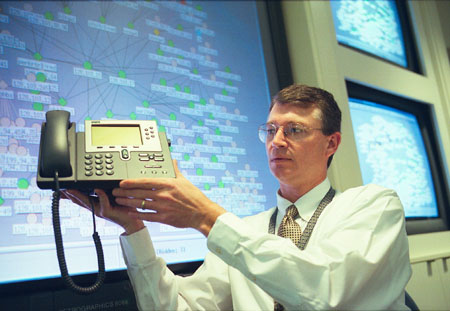Future phones face campus test today


The telephones of tomorrow are sitting on 100 desks across the University today in a pilot program that could give Harvard greater flexibility in deciding where and when to install a phone and simultaneously put the University at the leading edge of an eventual nationwide switch in telephone technology.
The new telephones transmit the sound of a caller’s voice via data lines, rather than the telephone lines. What this means is that the telephone acts much more like a computer attached to the Internet than an ordinary telephone.
Today’s Internet is unreliable for this application, however, because high traffic disrupts the telephone signals. The pilot program, therefore, is being conducted over Harvard’s internal data network, with outside calls switched to regular telephone lines.
“We are looking for experience in this new approach for voice for a number of reasons, not the least of which is understanding the real cost and the support issues,” said Nancy Kinchla, director of telecommunications services. “The technology is changing quickly, with upgrades happening often, and more features added constantly. It’s valuable to be in on this at the beginning and be able to influence vendors in terms of the user preference.”
The technology is called “Voice Over IP,” or “VoIP.” IP refers to the “Internet protocol” number that computers use to identify each other on the Internet. The telephones, which are essentially small computers, convert the telephone number to an IP address, which tells the system where the call is going.
“I wouldn’t even think of that as a phone,” said Leo Donnelly, senior technical analyst with University Information Systems and the pilot project’s technical lead. “It looks like a phone, but it’s just a software application, which could reside on a pda [personal digital assistant], a pc or other platform.”
One of the greatest attributes of the new telephones is flexibility, Donnelly said. With the new phones, the telephone number resides with the phone itself, rather than the jack in the wall, as with a traditional phone.
What that means is the phone can be plugged in anywhere there’s a data jack and work right away, rather than having to wait for the telephone company to come in, put in a line, and assign a number.
That could provide enormous flexibility, Donnelly said, when the University is hosting a conference and wants to put in a bank of phones, for example, or when a consultant comes in for two weeks and needs to have a phone number to receive calls. In cases like that, Donnelly said, all Harvard would need is a stock of phones that could be plugged in anywhere needed.
The phones could be used in more ordinary situations, such as that of a professor expecting a call who takes the telephone from the office to the lab so she doesn’t miss it. Because the number sticks with the phone, not the wall jack, the call would be routed to the lab automatically.
“I can pick up this phone and move it over to Langdell, plug it in and have the same number, the same voicemail,” Donnelly said during a recent demonstration of the technology at Maxwell-Dworkin. “It’s all about flexibility at the workstation.”
Though large-scale use of the phones over the Internet is not practical today, Kinchla said it might be possible someday. In fact, a couple of phones used in the pilot have been put in people’s homes, to test the potential for Internet communications.
Should it prove practical, the Internet could greatly enhance the flexibility being tested on campus today. A professor, for example, could take a phone on vacation to Florida, plug it into a data jack and have his Harvard extension operable there, with access to voicemail.
It could also mean the end of traditional long distance charges, as phones connect to each other much as a computer calls up a distant web page without incurring additional costs. Though those savings from long distance charges may one day be possible, Kinchla doubted whether any real savings would be realized, saying costs would likely just shift to the new network.
The project, headed by Project Manager Susan Delellis, was officially launched this month by a task force of members representing telecommunications and network staffs. They are working together to evaluate the technology, the quality, and the wide-ranging applications that could come from this marriage of voice and data.
Donnelly said several problems have already been identified, including lower volume and broken speech during times of high traffic over Harvard’s internal data network.
Other logistical problems include the routing of emergency 911 calls, made more difficult by a telephone that doesn’t have a fixed location. In the example of the professor who took the phone to the lab, if she has an accident, emergency crews might look first in the office, using precious time, before locating the professor in the lab.
Donnelly said it will be several years before the new phones are distributed widely, giving time for the technology to mature and bugs in the system to get worked out. VoIP is coming at a time when communications technologies are already converging, with pagers that get e-mail, cell phones that have telephone directories and web browsers, and personal digital assistants.
One participant in the trial, Kathleen Crowley, a telecom specialist at the Smithsonian Astrophysical Observatory, hasn’t been bowled over by the performance, citing voices cutting in and out during high-volume times on Harvard’s network.
In addition, she said, the VoIP phones don’t have all the features of the phones they replace, such as three lines on the phone for a single number, which ensures callers don’t get a busy signal. Though she has some complaints, Crowley said the whole point of the pilot program is to work the bugs out of the new technology. The project may test the phone’s flexibility by sending one to Japan to see if the Harvard extension still works.
“I’m enjoying the experiment so far. I think it’s an interesting prospect, but I’m reserving judgment,” Crowley said.
Scott Bradner, a technical consultant to University Information Systems and another pilot participant, just received his phone. He said a recent conference call between people on both the new and old phones had very good quality.
As the phones are programmable, Bradner said he expects the number of features offered to increase rapidly and for the VoIP phones to dramatically change what people expect from a telephone.
“We are at a time of dramatic change in the voice service world and VoIP will be a driver of much of this change,” Bradner said. “I expect that what people consider to be ‘voice service’ in five years will be much different than what we consider ‘voice service’ today – with many new interactive features.”
Contact Alvin Powell at alvin_powell@harvard.edu.




